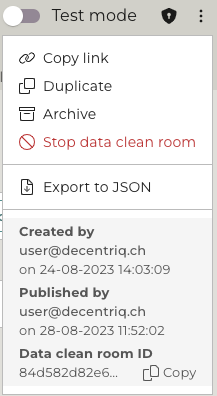Manage datasets via the SDK
Setup Script
If you want to test this functionality and don't have a clean room already set up, you can use this script to create an appropriate environment to test the rest of this guide with.
import decentriq_platform as dq
from decentriq_platform.analytics import *
USER_EMAIL = "@@ YOUR EMAIL HERE @@"
OTHER_EMAIL = "@@ OTHER EMAIL HERE @@"
API_TOKEN = "@@ YOUR TOKEN HERE @@"
client = dq.create_client(USER_EMAIL, API_TOKEN)
# build an example DCR
builder = AnalyticsDcrBuilder(client=client)
dcr_definition = builder.\
with_name("My DCR").\
with_owner(USER_EMAIL).\
with_description("My test DCR").\
add_node_definitions([
RawDataNodeDefinition(name="my-raw-data-node", is_required=True),
TableDataNodeDefinition(
name="my-table-data-node",
columns=[
Column(
name="name",
format_type=FormatType.STRING,
is_nullable=False,
),
Column(
name="salary",
format_type=FormatType.INTEGER,
is_nullable=False,
),
],
is_required=True,
),
]).\
add_participant(
USER_EMAIL,
data_owner_of=[
"my-raw-data-node",
"my-table-data-node",
]
).\
build()
dcr = client.publish_analytics_dcr(dcr_definition)
# Generate an encryption key
encryption_key = dq.Key()
# Read dataset locally, encrypt, upload and provision it to DCR
with open("/path/to/dataset.csv", "rb") as dataset:
DATASET_ID = client.upload_dataset(
dataset,
encryption_key,
"dataset_name",
)
Upload a dataset
# Generate an encryption key
encryption_key = dq.Key()
# Upload the dataset to the Decentriq platform
with open("/path/to/dataset.csv", "rb") as dataset:
dataset_id = client.upload_dataset(
dataset,
encryption_key,
"dataset_name",
)
List datasets and get details
datasets = client.get_available_datasets()
# Each such dataset is a dictionary:
dataset_name = datasets[0]["name"]
manifest_hash = datasets[0]["manifestHash"]
client.get_dataset(manifest_hash)
Deprovision and delete datasets
Deprovision a dataset
A deprovisioned dataset can no longer be used in a specific clean room, but remains available to be reprovisioned.
# Deprovision the dataset from the Table or File node
dcr.get_node("my-raw-data-node").remove_published_dataset()
Delete a dataset
A deleted dataset can no longer be provisioned to any clean rooms. Clean rooms that previously had the dataset provisioned may still have a copy cached. Therefore, before deleting a dataset from the Decentriq platform, it is best practice to deprovision it from any clean rooms using it first.
client.delete_dataset(DATASET_ID)
Copy IDs from the Decentriq UI to use in the SDK
To obtain a DCR ID
Access the DCR, click on the … icon in the top-right corner, then Copy ID.

To obtain a table or file node name
Use the same node name as you see in the UI.
To obtain a dataset ID
Access the Datasets page, locate the dataset and copy the ID displayed at the bottom of the details panel.